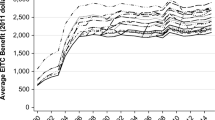Abstract
I present and test the hypothesis that the cost of living (COL) positively influences the labor force participation (LFP) of married women. Based on housing values and regional variables, I first predict COL for a sample of 150 metropolitan statistical areas (MSAs) using a smaller subsample for which geographically comparable family budget data are available for 1980. Results from estimating a logistic LFP model using census MSA data confirm my hypothesis and suggest that COL embodies locality-specific amenities rather than “pure” prices.
Similar content being viewed by others
References
Amemiya, Takeshi. “Qualitative Response Models: A Survey.” Journal of Economic Literature 19 (December 1981): 1483–536.
Becker, Gary S. “A Theory of the Allocation of Time.” Economic Journal 75 (September 1965): 493–517.
Ben-Porath, Yoram. “Labor-Force Participation Rates and the Supply of Labor.” Journal of Political Economy 81 (May/June 1973): 697–704.
Bowen, William G. and T. Aldrich Finegan. The Economics of Labor Force Participation. Princeton, N.J.: Princeton University Press, 1969.
Boyer, Richard and David Savageau. Places Rated Almanac: Your Guide to Finding the Best Places to Live in America. Chicago, Ill.: Rand McNally, 1981.
Cain, Glen C. Married Women in the Labor Force. Chicago, Ill.: University of Chicago Press, 1966.
Cain, Glen C. and Martin D. Dooley. “Estimation of a Model of Labor Supply, Fertility, and Wages of Married Women.” Journal of Political Economy (August, 1976): S179–99.
Clark, David E. and James R. Kahn. “The Social Benefits of Urban Cultural Amenities.” Journal of Regional Science 28 (August 1988): 363–77.
Fields, Judith. “A Comparison of Intercity Differences in the Labor Force Participation Rates of Married Women in 1970 with 1940, 1950, and 1960.” Journal of Human Resources 11 (Fall 1976): 568–77.
Fosu, Augustin K. “Labor Force Participation by Married Women: Recent Intercity Evidence.” Eastern Economic Journal 16 (July–September 1990): 229–38.
Getz, Malcom and Y.C. Huang. “Consumer Revealed Preference for Environmental Goods.” Review of Economics and Statistics 60 (August 1978): 449–58.
Gronau, Reuben. “Leisure Time, Home Production, and Market Work.” Journal of Political Economy 85 (December 1977): 1099–124.
—. “The Effects of Children on the Housewife’s Value of Time.” Journal of Political Economy 81 (March/April 1973): Par t 2, S168–99.
Groom, Phyllis. “A New City Worker’s Family Budget.” Monthly Labor Review 90 (November, 1967): 1–8.
Henderson, J. Vernon. “Evaluating Consumer Amenities and Interregional Welfare Differences.” Journal of Urban Economics 11 (January 1982): 32–59.
Izraeli, Oded. “The Effect of Environmental Attributes on Earnings and Housing Values across SMSAs.” Journal of Urban Economics 22 (November 1987): 361–76.
—. “The Effect of Variations in Cost of Living and City Size on the Rate of Return to Schooling.” Quarterly Review of Economics and Business 23 (Winter 1983): 93–108.
Johnston, J. Econometric Methods. 3rd ed. New York: McGraw-Hill, 1984.
Killingsworth, Mark R. Labor Supply. New York: Cambridge University Press, 1983.
— and James J. Heckman. “Female Labor Supply: A Survey.” In Orley Ashenfelter and Richard Layard, eds. Handbook of Labor Economics. Vol. I. New York: North-Holland, 1986, pp. 103–204.
Link, Charles R. and Ethel B. Jones. “A Simultaneous-Equation Model of Labor Supply, Fertility and Earnings of Married Women: The Case of Registered Nurses.” Southern Economic Journal 47 (April 1981): 977–89.
Long, James E. and Ethel B. Jones. “Part-Week Work by Married Women.” Southern Economic Journal 46 (January 1980): 716–25.
Mincer, Jacob. “Labor Force Participation and Unemployment: A Review of Recent Evidence.” In R.A. Gordon and M.S. Gordon, eds. Prosperity and Unemployment. New York: Wiley, 1966, pp. 73–112.
—. “Labor Force Participation of Married Women.” In H.G. Lewis, ed. Aspects of Labor Economics. Princeton, N.J.: Princeton University Press, 1962, pp. 63–10.
Moulton, Brent R. “An Illustration of a Pitfall in Estimating the Effects of Aggregate Variables on Micro Units.” Review of Economics and Statistics 72 (May 1990): 334–38.
Oates, Wallace E. “The Effects of Property Taxes and Local Public Spending on Property Values: A Reply and Yet Further Results.” Journal of Political Economy 81 (July–August 1973): 1004–8.
—. “The Effects of Property Taxes and Local Public Spending on Property Values: An Empirical Study of Tax Capitalization and the Tiebout Hypothesis.” Journal of Political Economy 77 (November/December 1969): 957–71.
Schultz, T. Paul. “The Influence of Fertility on Labor Supply of Married Women: Simultaneous Equation Estimates.” In Ronald G. Ehrenberg, ed. Research in Labor Economics. Vol. 2 Greenwich, Conn.: JAI Press, 1978, pp. 273–351.
Shapiro, David and Lois B. Shaw. “Growth in the Labor Force Attachment of Married Women: Accounting for Changes in the 1970s.” Southern Economic Journal 50 (October 1983): 461–73.
Smith, Barton A. “Measuring the Value of Urban Amenities.” Journal of Urban Economics 15 (July 1978): 370–87.
Smith, James P., ed. Female Labor Supply: Theory and Estimation. Princeton, N.J.: Princeton University Press, 1980.
Smith, Ralph E., ed. The Subtle Revolution: Women at Work. Washington, D.C.: Urban Institute, 1979.
Tiebout, Charles. “A Pure Theory of Local Expenditure.” Journal of Political Economy 64 (October 1956): 416–24.
Author information
Authors and Affiliations
Additional information
Part of the research for this paper was conducted while the author was Visiting Associate Professor at the Department of Economics and the Frederick Douglass Institute, University of Rochester, New York, during 1992–1993. The author thanks Oded Izraeli and Kevin J. Murphy for their helpful comments on earlier drafts and gratefully acknowledges the grant support of the Oakland University Research Committee.
Rights and permissions
About this article
Cite this article
Fosu, A.K. Cost of living and labor force participation: Married women in urban labor markets. J Labor Res 20, 219–232 (1999). https://doi.org/10.1007/s12122-999-1015-9
Issue Date:
DOI: https://doi.org/10.1007/s12122-999-1015-9




